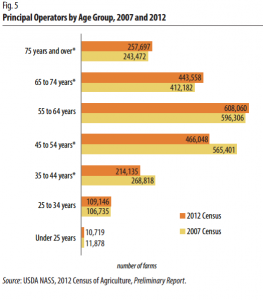The 2012 Agricultural Census
Every 5 years the United States Department of Agriculture (USDA) compiles a census of all farms in the United States. This data helps analyze trends and growth of not only prices, but number of farms as well. The numbers the USDA published are important for not only their emphasis on the effects of subsidies, but how our local agricultural economy is slowly becoming purely industrial. From the census we can draw several important distinctions.
Number of Farms. Over the past 30 years there has been a steady decline in the number of farms in the United States. While the overall number of farms is decreasing, the actual scales of those farms are growing in size. This is clearly demonstrating a direct trend towards urbanization of rural communities, as well as the increasing growth of industrial Agriculture. However, the amount of farms that still exist under 50 thousand dollars far outweighs the amount farm operating above the middle class. 75% of farms are still operating under 50k, while that is a 3% decrease since 2007, it outlines that the majority of U.S. farmers are still blue collar workers.
Farmers are aging. Each census shows that U.S. farmers are aging and the young are no longer directly replacing them. The trend began in 1974 and has continued to occur despite a continued emphasis on agricultural education in schools. The average age of a farmer is now 58 years old, and the number of Americans under 34 as farm operators have kept consistent. However, the number of Americans between 34 and 54 who operate farms is decreasing at a rapid pace.
Rapid Expansion. As the United States continues to grow, so does the agricultural sector. It would be assumed that as the U.S. becomes a technological driven society that farming would drop off. A 32.8% increase in overall sales would prove that belief inherently wrong. Research advances are occurring frequently within both biotechnology crops and conventional farming. Crops alone nearly rose 50% in sales, which can be attributed to a multitude of factors. Over the years observed there was an increased emphasis on ethanol, which boosted corn production significantly. This had an inverse effect on the prices of grains, livestock, and gasoline. By increasing the value of crops and livestock it created a huge boom in the sales of these products. Over time the value of crops and livestock has raised steadily until 2002. In 2002 the Bush administration passed a farm bill that would raise subsidy payments 74% over 10 years. In fact, without the subsidies in 2002, it is expected that prices would be even lower than they are now. This program recently ended and a revised farm bill, that did not include direct payments, was passed.
Conclusion. As society advances, the majority of small under 50k farms will be bought out as farmers age and retire. The amount of technology used in farming operations will only increase with advancement of technologies such as genetically modified organisms (GMOs), satellite imagery, and advanced soil monitoring techniques. While many farms are industrialized, there is a ¾ chance that your groceries came from a small farmer. The census further pushes the fact that in an industrializing world, an emphasis still exists on the local farmer.




While many farms are industrialized, there is a ¾ chance that your groceries came from a small farmer.
Very interesting!